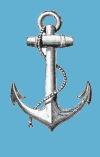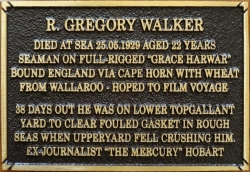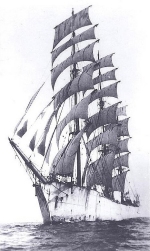 |
Tasmanian Seafarers' Memorial
|
 |
Ronald Gregory Walker (1929)
The plaque reads ...
 R. Gregory Walker
R. Gregory Walker
Died at sea 25.06.1929 aged 22 years
Seaman on full-rigged "Grace Harwar"
bound England via Cape Horn with wheat
from Wallaroo - hoped to film voyage.
38 days out he was on lower topgallant
yard to clear fouled gasket in rough
seas when upperyard fell crushing him.
Ex-journalist "The Mercury" Hobart

In 1929, young Hobart journalist, Ronald Gregory Walker, together with Alan J. Villiers, resigned from the literary staff of "The Mercury," and joined the Grace Harwar at Wallaroo (South Australia), with the intention of filming and making the first motion-picture descriptive of a Cape Horn voyage. Mr. Villiers, who had been at sea previously, joined the ship as able seaman, and Mr. Walker as ordinary seaman. The two left Hobart in March after a farewell function.
The last of the sailing vessels in the grain race from Australia, the Finnish full-rigged ship Grace Harwar left Wallaroo on April 17, 1929.
On May 25, 57 days out, Mr. Walker went to the top-gallant yard to clear a gasket, when the upper yard carried away, and crushed him. He was killed instantly, and brought down with difficulty.
He was buried from the poop on the following day, Sunday, May 26, with a service in Swedish and in English. There was neither an English nor an Australian ensign in the ship, and he went to his rest with the white and blue ensign of Finland around him.
The late Mr. Walker was only 22 years of age, and had been connected with the staff of "The Mercury" since 1924, having begun in the reading department as copy holder, and gradually worked his way to a position on the staff of graded journalists. It was only 12 months before, in company with Mr. J. P. Knowles, he had won a competition open to the whole State with his souvenir song, "My Island Home, Tasmania."
He was educated at the King's School, Parramatta (N.S.W.), where his father was a master, and later at the Hutchins School, Hobart, when his family came to Tasmania. His articles, written under the name of R. Gregory Walker, had won much appreciation not only in Tasmania, but also in mainland publications, and he had given many indications of a bright journalistic career.
Alan Villiers continued filming the voyage and eventually the footage was used in the film "Windjammer" which was shown at the Prince of Wales Theatre in Hobart in 1931, receiving tribute for its remarkable qualities, and to the ability and heroism of its Hobart acclaimed achievers, Alan Villiers and Ronald Walker.
Alan Villiers wrote later that "The shock was stunning. We did not - could not - believe it. Nowhere is the awfulness of death more painfully apparent than at sea."
![]()